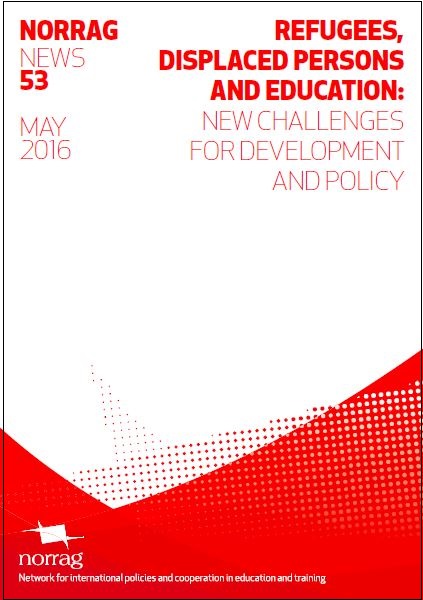Humanitarian Aid for Refugee Education: Why More is Needed By Aaron Benavot
By Aaron Benavot, Global Education Monitoring Report, UNESCO, Paris
Conflict in all its forms has taken a huge toll on education systems. While often the attention is on the source of the fighting, the visible influx of refugees seeking safe haven in Europe this last year has turned Western eyes towards the plight of refugees. What we know is that the scale, and the complexity, of the responses required to fulfil the education needs of those seeking refuge from the fighting are not being met. The fact is that insufficient humanitarian and development aid systems, together with insufficient levels of domestic financing, are leaving millions of displaced children and youth excluded from their right to a quality education.
Refugees suffer from almost every education challenge possible: a lack of infrastructure, a lack of learning materials, and of sufficiently knowledgeable and well supported teachers, as well as persistent barriers to learning posed by language, poverty and gender. Many desperately need skills for self-reliance, well-being and prosperity. If fulfilled, this would generate human capital in refugee communities, critical for repatriation to, and the rebuilding of, their homelands. Yet, their plight often goes unheard, and their education needs therefore unmet, because data on moving people are hard, if not impossible to collect.
While the word ‘refugees’ may initially bring to mind the recent influx of people into Europe, 86% of all refugees are hosted in developing countries, restricted to camps or struggling to fit into urban centres throughout the developing world. These protracted crises, and long-standing challenges they spawn, are not being addressed by traditional humanitarian assistance. Indeed, as a GEM policy paper showed (GMR, 2015), countries with long-term crises are receiving less than half the amount of development aid than others.
The exact figures of aid to refugees are not easy to find. Just as the data on refugee camps and settlements remain murky, so too are the exact breakdowns of humanitarian aid going to support their needs, certainly in the area of education. Current sums include refugees, but also extend to internally displaced persons (IDPs) and children who are neither IDPs nor refugees. Likewise, figures from the OECD DAC, which reports on external aid to refugees from donors, are not broken down by sector; so real clarity on how much is going to meet the pressing education needs of displaced children and youth is anyone’s guess.
What we do know is that humanitarian aid answered only 36% of education’s request for funds in 2014, compared to an average of 60% for other sectors. Development aid is similarly failing to prioritize education in conflict settings with just 10% of aid disbursed to the education sector in 2013. Funding for education from humanitarian pooled funding mechanisms is small: just 3% went to the education sector, while 25% went to health between 2010 and 2014. This all leads to just one conclusion: refugees, as a significant segment of the affected people needing this aid, are being left without international assistance.
In addition, media attention brings aid with it. This means that millions of refugees whose plight the media ignore, but who have been living in developing country camps their entire lifetime, have seen their school-aged years pass them by without support. Our analysis showed that just 4% of the 342 appeals made between 2000-2014 received over half of available humanitarian aid for education, all of which were heavily reported in the news.
It is a travesty that the education needs of so many displaced children and youth are left unanswered. Education provides them with shelter – literally and figuratively. It gives them essential knowledge and skills to thrive and survive following displacement and over the longer term. Overall, expanding education opportunity contributes to greater peace and security, as we will be showing in greater depth in the 2016 GEM Report. Clearly, those who hold the purse strings and those who make decisions on the ground must address the unmet needs of refugees, regardless of media visibility. Not doing so undermines our moral and collective responsibility to act with empathy and wisdom in the face of immense suffering.
Aaron Benavot is Director of the Education For All Global Monitoring Report team, c/o UNESCO, Paris. Email: a.benavot@unesco.org
Further Reading: UNESCO GEMR – UNHCR (May 2016) No More Excuses: Provide Education to All Forcibly Displaced People. Policy Paper
This blog is based on an article that appeared in NORRAG NEWS 53.
>> View the full list of articles in NN53 on ‘Refugees, Displaced Persons and Education: New Challenges for Development and Policy’
>> View all NORRAG Blogs on refugees/migration, ODA and Agenda 2030
NORRAG (Network for International Policies and Cooperation in Education and Training) is an internationally recognised, multi-stakeholder network which has been seeking to inform, challenge and influence international education and training policies and cooperation for almost 30 years. NORRAG has more than 4,500 registered members worldwide and is free to join. Not a member? Join free here.

